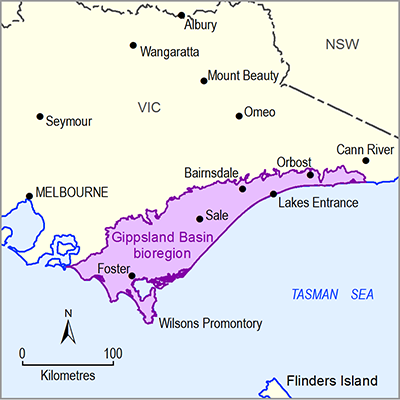Summary
The Gippsland Basin bioregion is located along the eastern slopes of the Great Dividing Range in Victoria and extends east and south to the coast. The Gippsland Basin bioregion is an ecologically diverse area. Natural forest, coastal plains and protracted dune systems are characteristic to the east, while the western area consists of high conservation value natural forest, fertile alluvial floodplains for agriculture and major coal deposits. The Gippsland Basin bioregion has however, been subjected to significant human pressure with 57% of the land area cleared of natural vegetation, predominantly for agricultural purposes.
Eucalyptus open forest and woodlands dominate the 43% of uncleared land in the bioregion and support unique grasslands across the Gippsland Plains. Plantation forestry covers 24% of the bioregion. Acacia spp., Melaleuca spp. and Banksia spp. forest or shrublands are associated with marine and estuarine environments. Approximately 24 flora and 45 fauna species are nationally listed as threatened in the Gippsland Basin bioregion by the Commonwealth’s Environment Protection and Biodiversity Conservation Act 1999 (the EPBC Act). Four threatened ecological communities are also listed, three of which are Critically Endangered. In 1981, Wilsons Promontory National Park was recognised as a United Nations Educational, Scientific and Cultural Organisation (UNESCO) biosphere reserve as it maintains a high percentage of diverse native vegetation.
Approximately 8350 wetlands have been classified in the Gippsland Basin bioregion. There are three state Heritage rivers, seven estuaries (including Gippsland Lakes), 15 nationally listed wetlands (A directory of important wetlands in Australia (DIWA); Department of the Environment, 2014) and three marine national parks. In 1982, Gippsland Lakes and Corner Inlet were both declared Ramsar wetlands of international importance in recognition of outstanding values, features and diversity of habitats. Marine areas are significant for migratory bird species of which 43 species are listed by the EPBC Act as threatened Migratory species.
Condition varies extending from the Great Dividing Range, across the Gippsland Plains to the coast. Many areas remain pristine in the east. However, an increase in environmental pressure and a decrease in condition occur due to land clearing, agriculture, forestry and other human activities across the Gippsland Plains. Lower river reaches are particularly affected.

